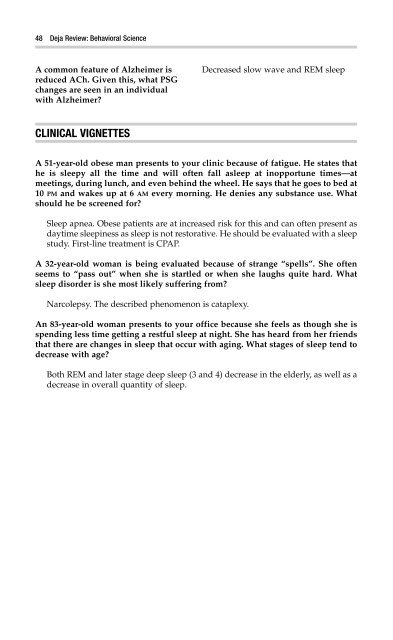Behavioral Science
You also want an ePaper? Increase the reach of your titles
YUMPU automatically turns print PDFs into web optimized ePapers that Google loves.
46 Deja Review: <strong>Behavioral</strong> <strong>Science</strong><br />
What interventions other than<br />
medications can be useful<br />
in insomnia?<br />
What is the subtype of recurrent<br />
primary hypersomnia associated with<br />
obesity, impulsivity, hyperphagia,<br />
hypersexuality, and disorganized<br />
thought called?<br />
Other than daytime sleepiness and<br />
“sleep attacks,” what symptoms are<br />
classically associated with narcolepsy?<br />
Which class of drugs is normally used<br />
to treat narcolepsy?<br />
Why are people with breathing-related<br />
sleeping disorder chronically sleepy<br />
during the day?<br />
What is the most common cause<br />
of breathing-related sleep disorder<br />
and how is it treated?<br />
In a patient with excessive fatigue,<br />
what might the patients’ bed partner<br />
tell you about their sleep that might<br />
lead you to suspect obstructive sleep<br />
apnea (OSA)?<br />
What are the complications from<br />
untreated OSA?<br />
Set a regular bedtime, abstain from<br />
caffeine and alcohol, use the bed only<br />
for sleep and sex, and avoid daytime<br />
naps and strenuous exercise or large<br />
meals just before bedtime. Collectively,<br />
this is referred to as sleep hygiene.<br />
Kleine-Levin syndrome<br />
Cataplexy: sudden loss of muscle<br />
tone associated with strong emotions<br />
Hypnagogic and hypnopompic<br />
hallucinations: REM intrusions that<br />
occur during the transition period<br />
between sleep and wakefulness<br />
(Hypnagogic symptoms occur when<br />
going to sleep and hypnopompic occur<br />
while waking up.)<br />
Sleep paralysis: inability to move just<br />
before going to sleep or awakening<br />
Stimulants, eg, Ritalin<br />
During the night they frequently stop<br />
breathing and then are awoken by<br />
hypoxia. These frequent arousals<br />
prevent the patients from getting deep,<br />
restful sleep.<br />
Obstructive sleep apnea (OSA)<br />
Treatment: continuous positive airway<br />
pressure (CPAP) and possibly removal<br />
of tonsils and adenoids (ideally weight<br />
loss would be primary intervention<br />
in the obese.)<br />
Loud snoring and periods of time<br />
where the patient appears to stop<br />
breathing<br />
Hypertension, pulmonary hypertension,<br />
and increased all-cause mortality,<br />
cardiovascular disease, and<br />
cerebrovascular disease



